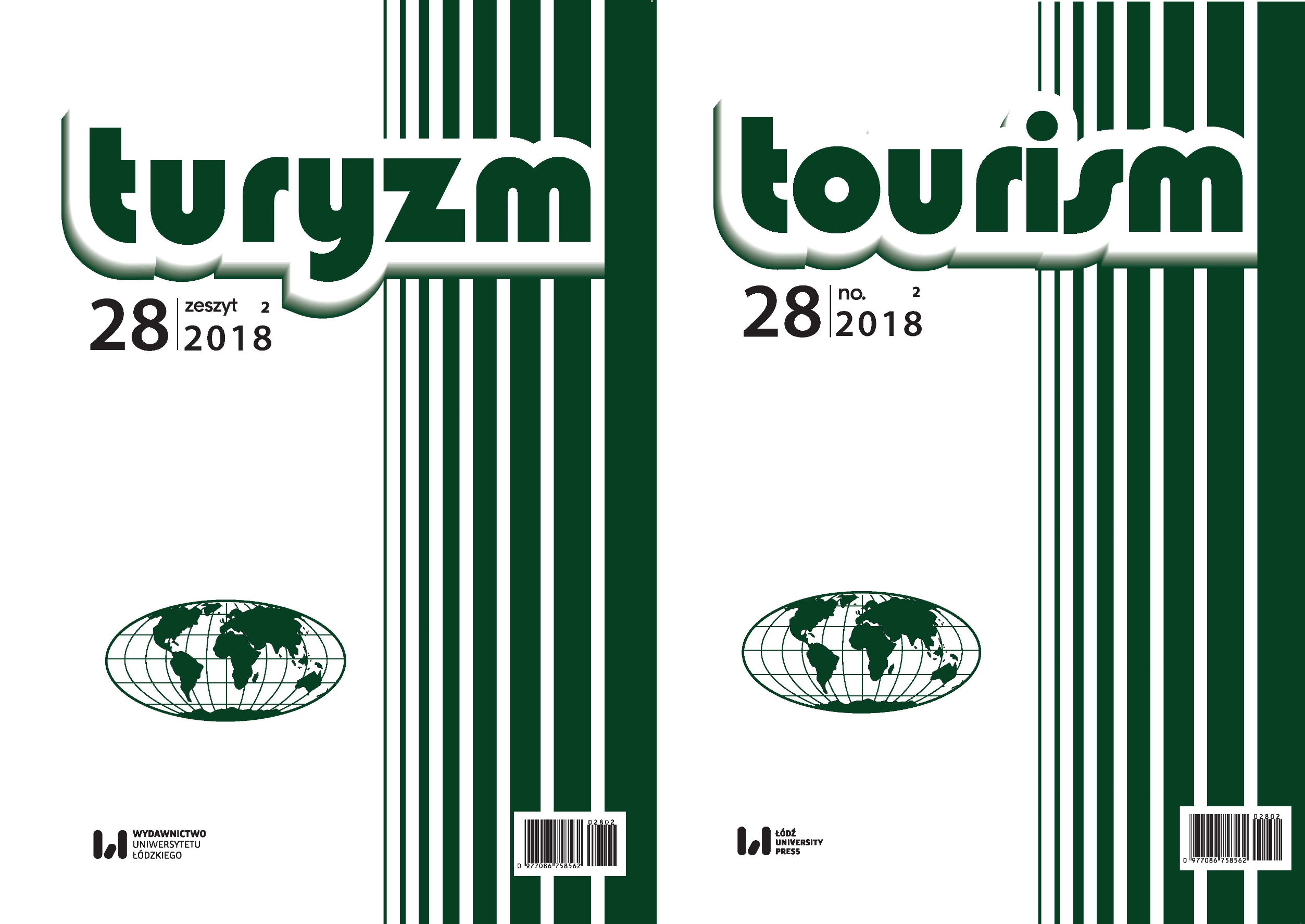Ruinisation and regeneration in the tourism space of Havana
DOI:
https://doi.org/10.2478/tour-2018-0009Słowa kluczowe:
regeneration, tourism space, ruinisation, social relations, HavanaAbstrakt
The author’s aim is to conduct an ethical analysis of degradation and regeneration processes in tourism space, using the example of Havana, Cuba. This is in the context of social relations between tourists and local inhabitants, as well as assessing the significance of regular patterns in these processes and their impact. As a result of the analysis, the author identified the causes of the ruinisation of tourism space in Havana, the exogenous and endogenous factors which influence this process, two types of regeneration undertaken as remedial action, as well as establishing the relationships between local inhabitants and tourists. The research results are followed by commentary indicating those elements of social relations which should be taken into consideration when starting a process of the urban regeneration of tourism space, in order to relieve present and potential conflicts between the inhabitants and tourists.
Pobrania
Bibliografia
AGARWAL S., SHAW G. (eds.), 2007, Managing costal tourism resorts: A global perspective, Channel View Publications, [s. l.].
Google Scholar
BONIFACE B.G., COOPER CH., 2001, Worldwide destinations: The geography of travel and tourism, Elsevier, [s. l.].
Google Scholar
BOUJROUF S., TEBBAA Q. (eds.), 2011, Tourisme et pauvreté, Editions des Archives Contemporaines, Paris.
Google Scholar
BUTLER R., 1980, The concept of a tourist area cycle of evolution: Implications for management of resources, The Canadian Geographer, 24, 1, pp. 5-12.
Google Scholar
BUTLER R.W. (ed.), 2006a, The tourism area life cycle, vol. 1: Applications and modifications, Channel Viev Publications, Clevedon–Buffalo–Toronto.
Google Scholar
BUTLER R.W. (ed.), 2006b, Tourism area life cycle, vol. 2: Conceptual and theoretical issues, Channel Viev Publications, [s. l.].
Google Scholar
COLANTONIO A., POTTER R.B., 2006, Urban tourism and development of the socialist state: Havana during the „special period”, Ashgate, [s. l.].
Google Scholar
COOPER CH. et al., 2005, Tourism: Principles and practice, Pearson Education, [s. l.].
Google Scholar
DEWAILLY J.M., 1996, L’espace touristique: du réel au virtuel, 28é Congrés sur la Géographie, Haga.
Google Scholar
DEWAILLY J.M., PLAMENT E., 2000, Le tourisme, Campus Géographie, SEDES, [s. l.].
Google Scholar
HARRISON D., 2001, Tourism and the less developed world: Issues and case studies, Cabi Publishing, [s. l.].
Google Scholar
HENTHORNE T.L., 2018, Tourism in Cuba. Casinos, castros and challenges, Emerald Publishing Ltd., [s. l.].
Google Scholar
JOHNSON D.L., LEWIS L.A., 2007, Land degradation: Creation and destruction, Rowman & Littlefield Publishers, Lanham–Boulder–New York–Toronto–Oxford.
Google Scholar
JOHNSTON C.S., 2001, Shoring the foundations of the destination life cycle model. Part 1: Ontological and epistemological considerations, Tourism Geographies, 3, 1, pp. 2-28.
Google Scholar
KACZMAREK S., 2001, Rewitalizacja terenów poprzemysłowych. Nowy wymiar w rozwoju miast, Wydawnictwo Uniwersytetu Łódzkiego, Łódź.
Google Scholar
KACZMAREK S., 2006, Urban tourism – the blessing or the curse, [in:] R.C. Lois Gonzáles (ed.), Urban changes in different scales: systems and structures, Universidade de Santiago de Compostela, [s. l.], pp. 361-368.
Google Scholar
KACZMAREK S., 2012, Kultura gospodarowania przestrzenią w mieście, Studia Miejskie, 5, pp. 9-19.
Google Scholar
KACZMAREK S., 2015, Degradacja i rewitalizacja przestrzeni turystycznej. Refleksja teoretyczna, [in:] M. Durydiwka, K. Duda-Gromada (eds.), Przestrzeń w turystyce. Znaczenie i wykorzystanie, Wydział Geografii i Studiów Regionalnych UW, Warszawa, pp. 27-37.
Google Scholar
KACZMAREK S., 2017, Demolowanie jako radykalne narzędzie w procesie rewitalizacji, Studia Miejskie, 28, pp. 9-20.
Google Scholar
KACZMAREK S., KOWALCZYK A., 2016, Rewitalizacja terenów poprzemysłowych i turystycznych, Folia Turistica, 41, pp. 283-309.
Google Scholar
KERR R., 2009, The metamorphosis of Cuban architecture; development, decay and opportunity, University of Edinburgh, Edinburgh.
Google Scholar
PEÑARANDA CURRIE L., 2012, From colonial port to postrevolution: Urban planning for 21st century Havana, consilience, The Journal of Sustainable Development, 8, pp. 50-69.
Google Scholar
REYNOLDS WOLFE L., 2000, Contesting the global restoration and neighborhood identity in Old Havana, http://lasa.international.pitt.edu/Lasa2000/ReynoldsWolfe.PDF; 21.07.2018.
Google Scholar
RYAN CH., 2003, Recreational tourism: Demands and impacts, Channel View Publications, Clevedon–Buffalo–Toronto-Sydney.
Google Scholar
SCHEYVENS R., 2002, Tourism for development: Empowering communities, Pearson Education, [s. l.].
Google Scholar
SMITH M., RICHARDS G., 2012, Routledge handbook of cultural tourism, Routledge, [s. l.].
Google Scholar
STAMM L., 2014, Deconstructing the dual city: pPreservation and tourism in La Habana Vieja, Senior Capstone Projects, Paper 385, Vassar College, Digital Window @ Vassar.
Google Scholar
VALLADARES A., 2018, The built environment in contemporary Old Havana: Building systems in a historic district, School of Urban Planning, McGill University, Montreal.
Google Scholar
WEAVER D., 2012, Sustainable tourism theory and practice, Routledge, [s. l.].
Google Scholar
WŁODARCZYK B., 2009, Przestrzeń turystyczna. Istota, koncepcje, determinanty rozwoju, Wydawnictwo Uniwersytetu Łódzkiego, Łódź.
Google Scholar
YIN R.K., 2014, Studium przypadku w badaniach naukowych. Projektowanie i metody, Wydawnictwo Uniwersytetu Jagiellońskiego, Kraków.
Google Scholar
Pobrania
Opublikowane
Jak cytować
Numer
Dział
Licencja

Utwór dostępny jest na licencji Creative Commons Uznanie autorstwa – Użycie niekomercyjne – Bez utworów zależnych 4.0 Międzynarodowe.










